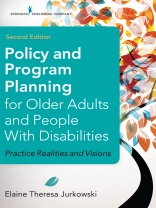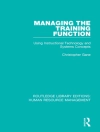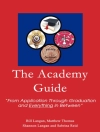The second edition of this landmark textbook is distinguished by its pioneering approach to encompassing disability and aging policies under one umbrella, in response to the newly developed Administration on Aging and Disability. It addresses policy changes impacting health and disability services resulting from the Affordable Care Act (ACA) and other new legislation, and offers a pioneering approach to transforming policy into practice applications. New to the second edition is current census data and new legislative mandates from the ACA and other policy organizations impacting aging adults and/or disabled populations. Also included is new coverage on Social Media, Motivational Interviewing, Health Literacy, Underrepresented Groups, LGBT, and Rural Communities. Podcasts, available as downloads, present the messages of advocates, lobbyists, policy experts, and consumers who address various aspects of relevant policies and policy development.
Unlike other texts, the book focuses on triangulating skills, policies, and programs for graduate students in social work, public health, gerontology, and rehabilitation. It aims thus to enhance understanding of policy development through a critical analysis and review of policy framework, and promotes development of skills in shaping programs and implementing policy. The text lays out tools that facilitate policy and program development to include the media, coalition building, the use of an evidence base, and how each mandated policy addresses these programs and services. Chapters include learning objectives, case studies, review/discussion questions, and resources for additional information. An Instructors Manual, Test Bank, and Power Point slides facilitate the teaching process.
New to the Second Edition:
- Addresses both disability and aging policies
- Includes updated census data
- Presents new legislation and mandates for the ACA, Veterans and the Military, Caregivers/Caregiver Support Act, Alzheimer Support, Health Lifestyles, Aging and Disability Resource Centers, Elder Justice Act, and Substance Use and Misuse
- Provides new coverage on Social Media, Motivational Interviewing, Health Literacy, Minorities, Incarcerated Individuals, Immigrants/Refugees, LGBT, and Rural Communities
- Offers podcasts of interviews with key consumers and policy experts
Key Features:
- Lays out tools that facilitate policy and program development
- Examines major service areas for older adults
- Addresses philosophical, historical, and demographic challenges
- Enhances understanding of policy development through critical analysis
- Includes learning objectives, case studies, review questions, and instructor package
قائمة المحتويات
Contents
Preface
Acknowledgments
Introduction
Share Policy and Program Planning for Older Adults and People With Disabilities: Practice Realities and Visions, Second Edition
PART I: Understanding Policy and Program Development
1. Background and Demographic Profile of People Growing Older and/or People With Disabilities
LEARNING OBJECTIVES
PREPARING FOR THE “BOOM”
THE CHANGING DEMOGRAPHIC STRUCTURE AND AGING POPULATION
CHANGES IN OUR POPULATION PROFILE
Living Arrangements
Education Level
Economic Well-Being
Changes in Rural Population
Trends in Morbidity and Mortality
THE CHANGING DEMOGRAPHIC STRUCTURE OF THE OLDER ADULT POPULATION WITH DISABILITIES AND IMPAIRMENTS
CHANGES WITHIN THE SOCIAL, POLITICAL, AND CULTURAL EXPECTATIONS OF COMMUNITIES
CHALLENGES FOR AGING AND DISABILITY POLICIES AND PROGRAMS
REALITIES AND VISIONS
DISCUSSION QUESTIONS
REFERENCES
2. Social, Political, Economic, and Demographic Factors and Historical Landmarks Impacting Aging and Disability Public Policy
LEARNING OBJECTIVES
THE ROLE OF HISTORICAL LANDMARKS IN SHAPING SOCIAL TRENDS AND PUBLIC POLICIES
THE RELATIONSHIP BETWEEN HISTORICAL LANDMARKS AND AGING AND DISABILITY-RELATED POLICIES
TRENDS IN POLICY, SOCIAL, AND POLITICAL INFLUENCES AND LANDMARKS IN THE UNITED STATES
The Roaring ‘20s: 1920–1929
The Dirty ‘30s: 1930–1939
The War-Torn ‘40s: 1940–1949
The Golden Age: 1950–1959
The Age of Technology Explosion: 1960–1969
The Decade of Presidential Resignation: 1970–1979
The Era of Economic Entrenchment: 1980–1989
The Era of Globalization: 1990–1999
The Dawning of a New Century: 2000–2009
The Age of Individualism (2010 and Beyond)
SUMMARY
DISCUSSION QUESTIONS
REFERENCES
3. Philosophical Paradigms and Policy Frameworks Impacting Aging and Disability Policy
LEARNING OBJECTIVES
PHILOSOPHICAL PARADIGMS AND THE RELATIONSHIP TO AGING POLICY AND POLICY ANALYSIS
WHAT IS POLICY ANALYSIS?
PHILOSOPHICAL PARADIGMS
Blaming the Victim
Elitism
Social Welfare as a Right
Econometric Perspectives
Cause Versus Function
Cronyism
Feminism
Public Policy Advocates’ Understanding of the Paradigms
IMPLEMENTATION STRATEGIES
Window of Opportunity
Implementation
Incrementalism
Rationalism
Street-Level Bureaucrats
Public Policy Advocates’ Understanding of the Implementation Strategies
A MODEL FOR SOCIAL WELFARE POLICY ANALYSIS
Social Problem/Social Issue
Goal
Policy or Legislation
Implementation of Policy or Legislation
THE USE OF NEEDS ASSESSMENTS FOR POLICY DEVELOPMENT AND COMMUNITY PLANNING
SUMMARY
DISCUSSION QUESTIONS
REFERENCES
4. Evidence-Based Policy Development: Tools for Public Policy Development and Analysis
LEARNING OBJECTIVES
WHAT IS AN EVIDENCE BASE?
WHAT IS EVIDENCE-BASED PROGRAM AND POLICY DEVELOPMENT?
WHY AN EVIDENCE BASE?
SOCIAL WORK AND PROGRAM PLANNING FOR OLDER ADULTS AND PEOPLE WITH DISABILITIES: AN AUTHORITY-BASED OR EVIDENCE-BASED PROFESSION?
APPROACHES TO EVIDENCE-BASED POLICY DEVELOPMENT
SOURCES OF EVIDENCE
Congressional Universe
Congress.gov Database
Government Printing Office
Government Accountability Office
Secondary Data Sources Useful in an Evidence-Based Approach
BENCHMARKS USED IN THE HEALTHCARE ARENA FOR PROGRAM PLANNING AND POLICY DEVELOPMENT
EVIDENCE AND ITS ROLE IN POLICY DEVELOPMENT AND COMMUNITY PLANNING
What Is a Needs Assessment?
SUMMARY
ADDITIONAL RESOURCES
Websites
DISCUSSION QUESTIONS
REFERENCES
PART II: The Legislative Basis for Programs and Services Affecting Older Adults and/or People With Disabilities
5. The Social Security Act
LEARNING OBJECTIVES
BACKDROP TO OUR CURRENT SOCIAL SECURITY PROGRAM
Social Security in Europe
The Genesis of Social Security in the United States
Contents of the Original Social Security Act
THE CURRENT SOCIAL SECURITY ACT
Some Guidelines for Social Security Programs
Basic Information When One Is Receiving Social Security Disability Benefits
About Benefits
Other Benefits One May Be Eligible for
What Must Be Reported to SSA?
SOCIAL SECURITY DISABILITY INSURANCE FOR CHILDREN
When a Child Reaches Age 18
If an 18-Year-Old Child Is Still in School
If a Child Is Disabled
If One Has a Stepchild and Gets Divorced
Reviewing One’s Medical Condition
Helping One Return to Work
Protection of One’s Personal Information
SOME REFORMS WORTH NOTING
PROPOSALS FOR REVISION AND WHY
Implications of a Privatized System
DILEMMAS FOR THE FUTURE
A Culture of Impoverished Older Adults
Older Women and Poverty
An Empty Pot at the End of the Rainbow
SUMMARY
DISCUSSION QUESTIONS
ADDITIONAL RESOURCES
Websites
You Tube Resources Related to Social Security
REFERENCES
6. Medicare
LEARNING OBJECTIVES
INTRODUCTION
HISTORICAL PERSPECTIVE
HOW DOES MEDICARE WORK?
Hospital Insurance (Part A)
Medical Insurance (Part B)
Costs of Medicare Part A Coverage
Part B Coverage Costs
Part B Costs for Those Qualifying for Original Medicare
Medicare Part C
Part C Coverage Costs
Medicare Part D
HOW DOES MEDICARE AFFECT ACCESS TO HEALTHCARE, COST CONTAINMENT, AND QUALITY?
WHAT IS MEDICAID AND HOW DOES IT DIFFER FROM MEDICARE?
Eligibility
Medicaid Waiver Opportunities
THE EFFECTS OF REIMBURSEMENT ON HEALTHCARE QUALITY, ACCESS, AND COSTS
CHALLENGES FOR THE FUTURE
An Empty Pot at the End of the Rainbow?
Rationing of Healthcare Services—To Be or Not to Be?
SUMMARY
CASE STUDY DISCUSSION
DISCUSSION QUESTIONS
ADDITIONAL RESOURCES
Websites
You Tube Resources Related to Medicare
Podcast
REFERENCES
7. The Older Americans Act
LEARNING OBJECTIVES
BACKGROUND AND OVERVIEW
THE OLDER AMERICANS ACT OF 1965
Title I: Definitions
Title II: Administration on Aging
Title III: Grants for Community Planning, Services, and Training
Title IV: Research and Development Projects
Title V: Training Projects
Title VI: General
AMENDMENTS TO THE OLDER AMERICANS ACT: 1967–2000
The National Family Caregiver Support Program
LEGISLATIVE AMENDMENTS OF 2016
Title I
Title II
Title III
Title IV
Title V
Titles VI and VII
The 2010 Reauthorization
LEGISLATIVE AMENDMENTS of 2016 (PL 114–144)
Aging and Disability Resource Centers
Area Plans
Disease Prevention and Health Promotion Services
Elder Abuse
Funding Formula
Holocaust Survivors
Home- and Community-Based Services
Long-Term Care Ombudsman Program
National Family Caregiver Support Program
Nutrition Services
Legal Assistance
Title IV Demonstration Projects
PHILOSOPHICAL PARADIGMS IMPACTING LEGISLATIVE AMENDMENTS
SUMMARY
USEFUL WEBSITES
Websites
You Tube Videos
Podcast
DISCUSSION QUESTIONS
REFERENCES
8. The Americans With Disabilities Act
LEARNING OBJECTIVES
THE INTERSECTION BETWEEN DISABILITY AND AGING
HISTORY OF THE DISABILITY MOVEMENT
THE JOURNEY TOWARD THE AMERICANS WITH DISABILITIES ACT
THE AMERICANS WITH DISABILITIES ACT OF 1990
Title I: Employment
Title II: Public Services
Title III: Public Accommodations and Services Offered Through Private Entities
Title IV: Telecommunications
Title V: Miscellaneous Provisions
IMPLICATIONS OF THE AMERICANS WITH DISABILITIES ACT ON THE AGING AND OLDER ADULT POPULATIONS
Title I: Employment
Title II: Public Services
Title III: Public Accommodations and Services Offered Through Private Entities
Title IV: Telecommunications
THE AMERICANS WITH DISABILITIES ACT AMENDMENTS OF 2008
Title I
Title II
Title III
Title IV
Title V
AGING AND DISABILITY RESOURCE CENTERS
SUMMARY
USEFUL WEBSITES
ADDITIONAL RESOURCES
You Tube Videos
Podcasts
DISCUSSION QUESTIONS
REFERENCES
9. Mental Health: The Community Mental Health Act
LEARNING OBJECTIVES
WHAT IS MENTAL HEALTH?
Definition of Mental Health
Paradigms of Mental Health
HISTORY OF LEGISLATIVE EFFORTS AFFECTING OLDER ADULTS AND OTHERS WITH MENTAL DISORDERS
The 2000 National Family Caregivers’ Support Program
The New Freedom Commission on Mental Health
INFLUENCES TO CONSIDER IN THE DEVELOPMENT OF MENTAL HEALTH LEGISLATION
Patterns of Service Utilization
Health Beliefs and the Role of Culture
A CURRENT MENTAL HEALTH PROFILE OF OLDER ADULTS AND PEOPLE WITH DISABILITIES IN THE UNITED STATES
A CLOSER VIEW OF THE MEANING OF MENTAL HEALTH
MH, Older Adults, and Physicians
MH, Older Adults, and Social Services
THE EPIDEMIOLOGY OF MH ISSUES OF OLDER ADULTS
Depression in Older Adults
Late-Onset Depression
Alzheimer’s Disease
Anxiety Disorders
Schizophrenia in Late Life
MH and Older Adults
MH in Rural Communities Versus Urban Communities
SOCIAL WORK, MENTAL HEALTH, AGING, AND SERVICE UTILIZATION
PROGRAMS AVAILABLE TO MEET THE MENTAL HEALTHCARE NEEDS OF OLDER ADULTS AND PEOPLE WITH DISABILITIES
Medicare
Medicaid
Area Agencies on Aging
SERVICE DELIVERY SETTINGS FOR MENTAL HEALTHCARE FOR OLDER ADULTS
ISSUES FACING OLDER ADULTS, PEOPLE WITH DISABILITIES, AND MENTAL HEALTHCARE NEEDS
Financing Mental Healthcare for Older Adults
Community-Based Care
Models for Gero-Psychiatry
Prevention Services
Screening and Detection
Medications
People With Chronic Mental Health Needs Who Are Aging
Oppressed Groups and Visible Minorities
MODEL PROGRAMS AND BEST PRACTICE APPROACHES TO MENTAL HEALTH SERVICE DELIVERY
The Center for Older Adult Recovery at Hanley Center
The Gatekeeper Program
MENTAL HEALTHCARE CHALLENGES FOR THE FUTURE
SUMMARY
ADDITIONAL RESOURCES
Websites
You Tube Videos
Podcast
DISCUSSION QUESTIONS
REFERENCES
10. The Patient Protection and Affordable Care Act
LEARNING OBJECTIVES
THE AFFORDABLE CARE ACT BECOMES LAW
COMPONENTS OF THE ACA
Title I: Quality, Affordable Healthcare for All Americans
Title II: Role of Public Programs
Title III: Improving the Quality and Efficiency of Healthcare
Title IV: Prevention of Chronic Disease and Improving Public Health
Title V: Healthcare Workforce
Title VI: Transparency and Program Integrity
Title VII: Improving Access to Innovative Medical Therapies
Title VIII: Class Act
Title IX: Revenue Provisions
Title X: Strengthening Quality, Affordable Healthcare for All Americans
SUMMARY
DISCUSSION QUESTIONS
ADDITIONAL RESOURCES
You Tube Videos
Websites
Podcasts
REFERENCES
11. Caregivers/The Caregiver Support Act
LEARNING OBJECTIVES
CAREGIVERS AND THE CAREGIVER SUPPORT ACT
RAISE FAMILY CAREGIVERS ACT—PUBLIC LAW 115–119
Importance of Family Caregivers
A CURRENT PROFILE OF RELATIVE CAREGIVERS RAISING CHILDREN IN THE UNITED STATES
REASONS FOR THE INCREASE IN RELATIVE CAREGIVING
ISSUES FACING GRANDPARENTS RAISING GRANDCHILDREN
Poverty
Social/Role Issues
Socialization
Healthcare
Policy and Legislation
PROGRAMS AVAILABLE TO MEET THE NEEDS OF RELATIVE CAREGIVERS AND GRANDPARENTS RAISING GRANDCHILDREN
Medicare
Medicaid
Area Agencies on Aging
Child Welfare
MODEL PROGRAMS AND PROACTIVE APPROACHES TO ADDRESSING THE NEEDS OF GRANDPARENTS SERVING AS CAREGIVERS FOR GRANDCHILDREN
CHALLENGES FOR RELATIVE CAREGIVERS AND GRANDPARENTS RAISING GRANDCHILDREN IN THE FUTURE
SUMMARY
ADDITIONAL RESOURCES
Websites
You Tube Videos
Podcasts
DISCUSSION QUESTIONS
REFERENCES
12. The Elder Justice Act
LEARNING OBJECTIVES
THE ELDER JUSTICE ACT
LEGISLATIVE PROVISIONS ADDRESSED WITHIN THE ELDER JUSTICE ACT
A CURRENT PROFILE OF ELDER ABUSE FACING OLDER ADULTS IN THE UNITED STATES
WHO REPORTS ELDER ABUSE?
PROGRAMS AND SERVICES AVAILABLE TO ADDRESS ISSUES OF ELDER ABUSE
Medicare
State-Based Services Offered Through Departments on Aging
The Centers for Disease Control and Prevention
Area Agencies on Aging
TYPES OF ELDER ABUSE AND NEGLECT
MODEL PROGRAMS AND BEST-PRACTICE APPROACHES TO ADDRESSING THE LEGAL NEEDS OF OLDER ADULTS
Breaking the Silence—Media Campaign (Illinois Department on Aging)
The B*SAFE Program
CHALLENGES FOR ELDER ABUSE AND NEGLECT PROGRAMS IN THE FUTURE
CHALLENGES FOR LEGAL ISSUES IN AGING FOR THE FUTURE
LEGAL ISSUES AND OLDER ADULTS
POWER OF ATTORNEY
Types of Powers of Attorney
Legal Authority Granted via a Power of Attorney
Selecting an Agent for a Power of Attorney
Monitoring and Oversight
HEALTHCARE POWER OF ATTORNEY
Living Wills and Advance Directives
PROGRAMS AND SERVICES AVAILABLE TO ADDRESS LEGAL ISSUES FOR OLDER ADULTS
Medicare
State-Based Departments on Aging
The Older Americans Act and Area Agencies on Aging
MODEL PROGRAMS AND BEST PRACTICES TO ADDRESS THE LEGAL NEEDS OF OLDER ADULTS
American Association of Retired Persons
American Society on Aging
CHALLENGES FOR LEGAL ISSUES IN THE AGING ARENA FOR THE FUTURE
SUMMARY
ADDITIONAL RESOURCES
Websites
You Tube Videos
DISCUSSION QUESTIONS
REFERENCES
13. Housing and Long-Term Care
LEARNING OBJECTIVES
A HISTORICAL OVERVIEW OF HOUSING POLICY AND OPTIONS FOR PEOPLE GROWING OLDER AND PEOPLE WITH DISABILITIES
A CURRENT PROFILE OF LONG-TERM CARE AND COMMUNITY-BASED CARE NEEDS
AN OVERVIEW OF THE PROGRAMS TO MEET HOUSING NEEDS OF OLDER ADULTS
Senior Apartments
Categories of Senior Apartments
STRATEGIES FOR REMAINING IN ONE’S HOME
Home Equity Conversion
Sale Leaseback
MAINTENANCE PROGRAMS
Home Maintenance and Repair
Illinois Home Weatherization Assistance Program
ISSUES FACING LONG-TERM AND COMMUNITY-BASED CARE FOR OLDER ADULTS
Long-Term Care Facilities
Assisted Living Facilities
Community-Based Care
Consumer-Directed Home Help and Care Options
People With Disabilities Requiring Community-Based Care
OPPRESSED GROUPS AND VISIBLE MINORITIES
SUMMARY
DISCUSSION QUESTIONS
ADDITIONAL RESOURCES
Websites
You Tube Videos
Podcast
REFERENCES
14. Substance Use and Misuse
LEARNING OBJECTIVES
LEGISLATIVE HIGHLIGHTS RELATED TO SUBSTANCE ABUSE/MISUSE
WHAT IS THE SCOPE OF SUBSTANCE MISUSE?
The State of Opioid Use
Alcohol and Substance Abuse Disorders
Substance Use/Abuse and People with Disabilities
SOCIAL WORK, MENTAL HEALTH, AGING, AND SERVICE UTILIZATION
PROGRAMS AVAILABLE TO MEET THE SUBSTANCE ABUSE CARE NEEDS OF OLDER ADULTS
Medicare
Medicaid
Area Agencies on Aging
SERVICE DELIVERY SETTINGS FOR SUBSTANCE USE/MISUSE CARE FOR OLDER ADULTS AND PEOPLE WITH DISABILITIES
ISSUES FACING OLDER ADULTS AND PEOPLE WITH DISABILITIES WITH SUBSTANCE ABUSE/MISUSE CARE NEEDS
Financing Mental Healthcare for Older Adults
Community-Based Care
Models for Gero-Psychiatry
Prevention Services
Screening and Detection
Medications
MODEL PROGRAMS AND BEST-PRACTICE APPROACHES TO SUBSTANCE USE/MISUSE SERVICE DELIVERY
The Center for Older Adult Recovery at Hanley Center
SUBSTANCE USE/MISUSE CARE CHALLENGES FOR THE FUTURE
SUMMARY
DISCUSSION QUESTIONS
ADDITIONAL RESOURCES
Websites
You Tube Videos
Podcast
REFERENCES
PART III: Tools for Policy and Program Development
15. Health Behavior Models and Health Promotion Frameworks
LEARNING OBJECTIVES
WHAT ARE HEALTH PROMOTION FRAMEWORKS?
HEALTH PROMOTION FRAMEWORKS AND HEALTH POLICY
The Health Belief Model
The Theory of Reasoned Action
Transtheoretical Model and Stages of Change Theory
IMPLICATIONS OF THE HEALTH PROMOTION MODELS AND PROGRAM DEVELOPMENT FOR AGING AND DISABILITY-RELATED PROGRAMS AND SERVICES
SUMMARY
ADDITIONAL RESOURCES
Websites
You Tube Videos
DISCUSSION QUESTIONS
REFERENCES
16. Media, Social Media, and Advocacy Strategies for Change
LEARNING OBJECTIVES
ADVOCACY AND ITS ROLE IN PROGRAM AND POLICY DEVELOPMENT
THE USE OF MEDIA ADVOCACY
What Is Media Advocacy?
When Using Media for Advocacy
FORMS OF MEDIA ADVOCACY
Newspaper Articles
News Releases
Letters to the Editor
Radio Spots or Television Interviews
Media Events or Press Briefings
Fact Sheets
Media Artifacts
Social Media
WHAT STRATEGIES ARE BEST TO USE?
Consider the Audience
Consider the Message
Consider Time
Consider Financial Resources
Consider Human Resources
USING MEDIA ADVOCACY FOR POLICY DEVELOPMENT AND PROGRAM PLANNING
SUMMARY
ADDITIONAL RESOURCES
Websites
You Tube Videos
Podcast
DISCUSSION QUESTIONS
REFERENCES
17. Coalitions and Coalition Building for Advocacy and Policy Development
LEARNING OBJECTIVES
WHY ADVOCACY?
STRATEGIES FOR ADVOCACY: COALITION BUILDING
What Are Coalitions?
What Are Some Reasons for Developing Coalitions?
PARTNERS FOR COALITION ENTITIES
Academia
Public Health Expertise
Human Service Providers
Consumer Organizations
Faith-Based Communities
Law and Safety Enforcement
Media/Education
Volunteer Associations
Sports and Recreation Entities
HOW DO WE BUILD COALITIONS?
COMMUNICATION SKILLS FOR EFFECTIVE COMMUNITY NEGOTIATIONS
Sources of Conflict
Roles of Coalition Members
Understanding the Roles Participants Will Take On
What Influences These Roles Within Coalitions?
MODEL COALITIONS AND THEIR OUTCOMES
The National Coalition on Mental Health and Aging
The Ontario Healthy Communities Coalition
Quad Counties Mental Health and Aging Coalition
The National Federation of the Blind
The Coalition of Health and Disability Advocates
The Coalition of Citizens With Disabilities
The Pioneer Network Coalition
SUMMARY
ADDITIONAL RESOURCES
Websites
Videos
DISCUSSION QUESTIONS
REFERENCES
18. Needs Assessment Tools
LEARNING OBJECTIVES
INTRODUCTION
WHO IS RESPONSIBLE FOR CARRYING OUT NEEDS ASSESSMENTS?
WHY WOULD INDIVIDUALS, GROUPS, OR ORGANIZATIONS BE INTERESTED IN CONDUCTING A NEEDS ASSESSMENT?
CORE CONCEPTS OR BUILDING BLOCKS THAT SERVE AS A FOUNDATION FOR NEEDS ASSESSMENTS
Need
Target Groups
Systems
Outcomes
Plan of Action
Evidence Base
STRATEGIES FOR DEVELOPING A NEEDS ASSESSMENT
Social Indicators
Key Informants
Community Forum
Field Study and Survey Data
Rates Under Treatment or Agency Service Data
Focus Groups
Environmental Scans
A MODEL FOR NEEDS ASSESSMENT
SUMMARY
ADDITIONAL RESOURCES
Websites
You Tube Videos
Podcast
DISCUSSION QUESTIONS
REFERENCES
19. From Tools to Vision
LEARNING OBJECTIVES
USING TOOLS AND STRATEGIES TO REACH YOUR VISION
FROM TOOLS TO POLICY DEVELOPMENT
FROM TOOLS TO PROGRAM DEVELOPMENT
SUMMARY
DISCUSSION QUESTIONS
REFERENCES
PART IV: Realities and Visions for the Future
20. Challenges for Policy and Program Planning for the Future: Realities and Visions for the Future
LEARNING OBJECTIVES
INTRODUCTION
THE TOP 10 LIST OF CHALLENGES FOR THE FUTURE IN THE AREAS OF DISABILITY AND AGING
1. Designing Paradigms to Meet the Demographic and Social Needs of Our Graying and Disabled Populations Through Evidence-Based Approaches
2. Social Security
3. Medicare
4. Understanding Health Behavior and Planning With This Understanding in Mind
5. Using the Media, Advocacy, and Coalitions for Social Change
6. Home- and Community-Based Care
7. Mental Health Programs, Services, and Issues
8. Health Programs, Services, and Issues
9. Long-Term Care
10. Diversity and Special Populations
SUMMARY
REFERENCE
Appendix A: Regional Support Centers
Appendix B: Healthy People 2020 Objectives for Older Adults
Appendix C: Healthy People 2020 Objectives for Disability and Health
Appendix D: Overview of Relevant Legislation That Impacts Older Adults and People With Disabilities
Appendix E: Aging and Disability Resource Centers
Appendix F: Overview of ICD-10 and ICF: Application to People With Disabilities and Older Adults
Patricia Welch Saleeby
Index
عن المؤلف
Elaine Theresa Jurkowski, Ph D, MSW, is a professor at Southern Illinois University Carbondale’s School of Social Work, where she teaches courses in health and aging policy, research, and program evaluation and social work practice. Dr. Jurkowski also holds joint appointments with the Department of Public Health and Recreation Professions and SIU’s School of Medicine’s Family Practice Residency Program.












